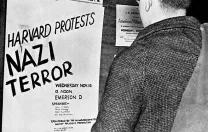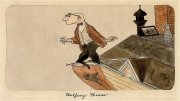What made the success of this grassroots movement possible? Certainly the leadership, effort, and energy of a few extraordinary individuals played a major role. The student leaders proved remarkably savvy in the mechanics of organizing a social movement—not just in devising their bold vision of going national even before the Harvard plan itself was set, but in everything else, from drawing on existing campus and national organizations to finding faculty and administration allies, gaining endorsements from prominent individuals, and achieving fundraising goals.
Other factors lie deeper. The students’ initiative—not only at the College, but nationwide—also reflects the fortuitous superposition of two waves of different frequency that overlapped: the shorter oscillation of students’ inward or outward orientation, and the longer trend of institutional transformation.
|
Inspired partly by New Deal activism, partly by a revival of the labor-union movement, and partly by deeply troubling events in Europe and elsewhere, a generation of students was ready to look outward. The brushfire growth of the Harvard initiative and the rapid flaring up of local initiatives at other colleges showed that fuel for such an action existed on many American campuses. The Harvard students provided the initial spark and thus focused and transformed widely held sentiments and predispositions into organized action.
The events of the late 1930s also highlight the slower trend in American higher education toward a meritocracy defined by scholarly achievements. That meant admitting talented young individuals from more segments of the population, and, most conspicuously, Jews. The refugee scholarships, through their emphasis on academic prowess, their international orientation, and their predominantly Jewish recipients, epitomized this trend. But Robert Lane himself represented a more subtle element of the larger process: the inclusion of the WASP middle class, especially its professional segments, in premier private colleges such as Harvard. (A native Midwesterner and the son of professional parents, a teacher and a nonprofit administrator, Lane notes that, although he considered himself an outsider vis-à-vis the WASP elite, he “always recognized that, as a Harvard WASP, I was useful to left-wing organizations, many of whose members were New York Jews.”)
The students who pushed the Corporation to action in less than two weeks were also well connected to the American elite and thus were able to secure quick public endorsements by the powerful and famous. According to Lane, the student group included at least one “super-WASP”—Philip Bagby, whose uncle George Gordon Battle, a prominent New York attorney, was influential in winning an endorsement of Harvard’s refugee work from New York governor Herbert Lehman. Lane’s father was at the time director of the Welfare Council of New York City, which, among other things, dealt with child refugee issues. Fellow undergraduate Robert B. Ridder belonged to one of the foremost families in American newspaper publishing. Law student Abba Schwartz was a protégé of Felix Frankfurter; he was “a great friend and mature counsel,” Lane recalls, “[probably sent by Frankfurter] to monitor us, but Abba was on our side.” It is a reasonable guess that the Roosevelt endorsement was facilitated through Schwartz’s contacts with Frankfurter.
Lane’s and Schwartz’s contacts also illuminate the changing composition of the American elite (which even at the time was no longer exclusively populated by WASP patricians). Here, a few pairings may symbolize how much, by the 1930s, more “progressive” WASP patricians had already amalgamated with new elements (be they non-elite WASP, other ethnicities, or Jews), and how they joined forces in support of the refugee students: Bagby and Schwartz (among the leaders of the student activists); the St. Paul Society and the Avukah Society (among student supporters); and Roosevelt and Frankfurter (among political figures).






